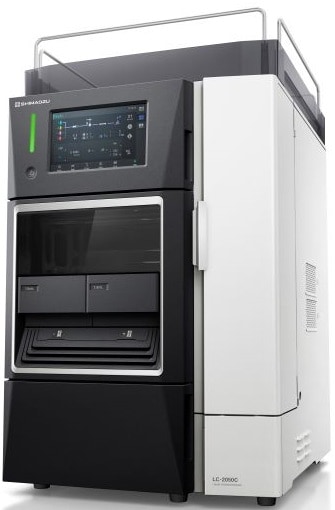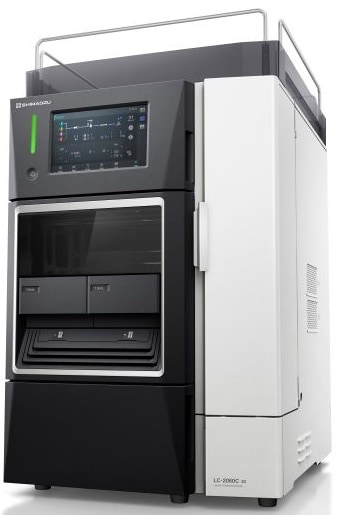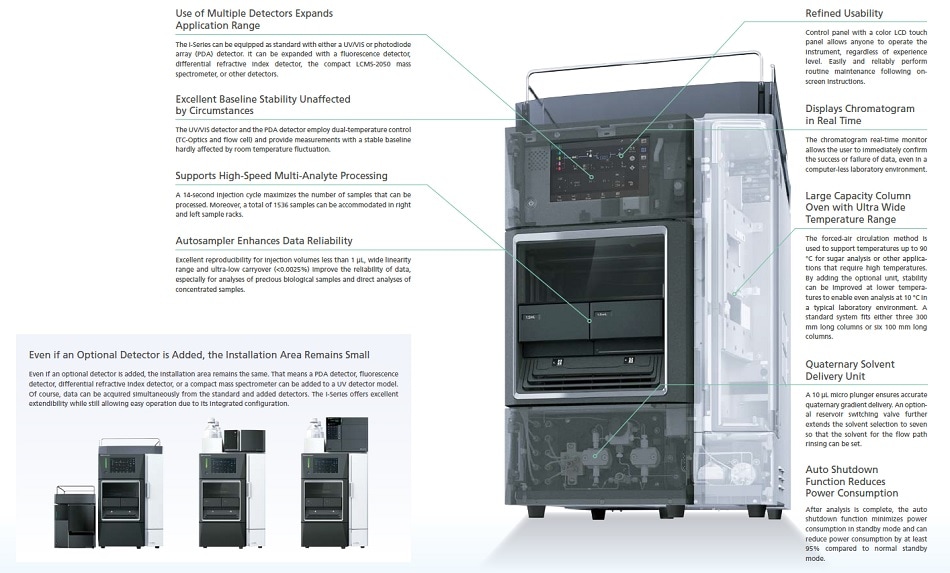i-Series
High Performance Liquid Chromatograph
Amid increasing calls for improved work efficiency and a more flexible working style, ideas of LC analysis are changing. The time has come for an HPLC that delivers rugged, reliable results with less frequent interaction by the analyst. The new, integrated i-Series LC system maintains the excellent performance of its predecessor while addressing the need for automation efficiency.
Lineup
HPLC model : LC-2050 series (pressure resistance 50 MPa)

Three types of detector setup (UV, PDA, detector-less) are available to suit your analysis methods and aims. In addition, we provide models both with oven cooling functions (C model) and without.
| Model Name | Sample cooler | Detector |
|---|---|---|
| LC-2050 | UV | |
| LC-2050C | √ | UV |
| LC-2050C 3D | √ | PDA |
| LC-2050C LT | √ | − |
UHPLC model : LC-2060 series (pressure resistance 70 MPa)

This is our 70 MPa UHPLC model. The method transfer system provides excellent support for running UHPLC and HPLC methods on one device.
| Model Name | Sample cooler | Detector |
|---|---|---|
| LC-2060 | √ | UV |
| LC-2060 3D | √ | PDA |
| LC-2060C 3D MT∗ | √ | PDA |
∗ MT : Method transfer system
Features
-
Remote instrument operation and monitoring allow analyses to be performed remotely, thereby reducing the time spent in the laboratory.
-
Software integration ensures both data reliability and improved work efficiency.
-
Intuitive operation ensures an efficient workflow.
-
Videos
-
Simultaneous Analysis of 10 Saccharides and Sugar Alcohols in Beverages by Nexera LC-40 and ELSD
This video presents you the simultaneous analysis and separation of 10 saccharides and sugar alcohols in beverages by Shimadzu Nexera LC-40 and ELSD. Saccharides and sugar alcohols show very narrow UV absorption wavelength range, from 190 nm to 195 nm. Therefore, a refractive index detector (RID) is commonly used for this analysis. However, gradient elution cannot be used with RID because the baseline drifting derived from the change of mobile phase composition during gradient elution is unacceptable. So, RID is not suitable for a simultaneous separation of compounds that show widely different retention behaviours due to expected long analysis time without gradient elution. Evaporative light scattering detector (ELSD) is one of universal detector that detects the scattering light from the target compounds after nebulizing and evaporating the mobile phase. ELSD provides reduced analysis time and simultaneous separation of compounds that show widely different retention due to applicability to gradient elution. The performance of Nexera LC40 and ELSD was evaluated by intra-day and inter-day repeatability tests. Good intra and inter-day reproducibility results show the analysis method and systems are very stable.
-
i-Series
The new, integrated i-Series LC system keeps the excellent performance of its predecessor but also addresses the demands of an increasingly varied range of users, locations, and approaches to analysis while always delivering highly reliable analytical results.
-
i Series - A more flexible work day
-
Shimadzu Nexera X2 Complete Separation of Co-eluted Peaks by i-PDeA
-
Automatic Amino Acid Analysis with Online Pre-column Derivatization by Shimadzu HPLC
This video presents you the fully automated pre-column derivatization of the amino acids. A Shimadzu Prominence-i Plus with photodiode array (PDA) and fluorescence (RF) detectors were employed for the analysis. The Prominence-i Plus with automated co-injection function allows several derivatization reagents to be aspirated sequentially from multiple vials and mixing within the needle and the sample loop to speed up and increase the analysis efficiency. This true turnkey solution delivers great productivity and increase analysis throughput compare to traditional manual derivatization.
-
Analysis of Lutein in Spinach using HPLC
This demo video shows how to analyze lutein in spinach samples using Shimadzu HPLC. For sample preparation, spinach samples were cut and blended. After that, pyrogallol-ethanol and KOH were added to the samples and heated at 70℃ for 30 min. After cooling down, NaCl and n-hexane-ethyl acetate were added for extraction. The extract was dried by rotary evaporator and reconstituted with BHT-ethanol. Filter the solution with a PTFE membrane filter and collect the filtrate in an amber vial. The ready sample can be injected for HPLC analysis.
-
Analysis of Ascorbic Acid - also Known as Vitamin C- using HPLC in Banana
In this video, we will talk about the analysis of ascorbic acid, also known as vitamin C using HPLC.
-
Determination of Preservatives in Food, Cosmetics and Personal Care Products by Shimadzu HPLC
This video presents you the quantitative determination of 6 preservatives in various types of sample matrices which are food, cosmetics, and personal care products by Shimadzu Advanced i-Series HPLC. Preservatives are substances added to inhibit or prevent the process of fermentation, acidification, or deterioration of foodstuffs caused by microbial contamination. They are also added in cosmetics and personal care products to maintain quality and safety. Excess amount can be harmful to health. Minimum permissible concentrations are regulated and because of that, the analytical determination of these preservatives is important to ensure safety for the consumers. Shimadzu Advanced i-Series with UV detector were employed for this analysis. All 6 preservatives are well separated in less than 10 minutes under the gradient elution method. Two preservatives, methyl and ethyl parabens detected in the toothpaste sample. Sorbic acid was detected in the food sample, whereby three parabens, methyl, ethyl, and propyl parabens were detected in the cosmetic sample. The linearities of the calibration curves of the 6 preservatives were excellent and the R2 values which are all 0.999 or greater. The calibration curves were used to quantitate preservatives in all the samples.
-
How to do HPLC method validation
This video introduces parameters that are included in HPLC method validation. Method validation for a HPLC method is required in a lab and is common work of a chemist. It is a process to evaluate the performance of a method to ensure it meet the requirements for its intended use. Shimadzu Nexera and i-series HPLC system with LabSolutions workstation enhance HPLC method performance, thus making method validation work at ease. HPLC method parameters such as selectivity, linearity and range, precision, accuracy, limit of detection (LOD), limit of quantitation (LOQ) and robustness are discussed.
-
Total BioPharma Workflow | Shimadzu
This video presents Shimadzu's solutions for Total Biopharma Workflow. Currently, the biopharma market is seeing the rise of exciting trends such as innovative biotherapeutics developed to treat illnesses including cancer and autoimmune diseases. However, these biomolecules are much more complex than small molecules and thus difficult to perform extensive analytical characterization.
-
Shimadzu’s Living LC – The Advanced i-Series | Shimadzu
The video presents Shimadzu’s launch of the Living LC – the Advanced i-Series. Incorporating our proprietary technology, the Analytical Intelligence, this instrument offers a fully automated analytical workflow with the highest data security, thereby driving laboratories towards higher throughput, more robust analytical capabilities, and better data-driven decisions.












